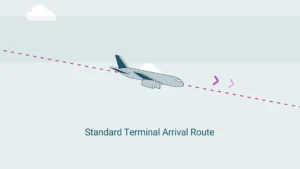Ever wondered how planes know where to go when they’re getting close to an airport? That’s where Standard Terminal Arrival Routes (STARs) come in handy! These are like special roadmaps in the sky that help planes safely make their way to the airport when they’re flying by instrument rules. STARs are super helpful for keeping things organized and safe, especially around busy airports where there’s a lot of air traffic. They’re designed to make sure planes can smoothly transition from flying high up to getting ready for landing.
Why STARs are Awesome
- They save time and fuel: STARs help planes take the best route to the airport, so they don’t waste time or fuel flying in circles or taking long detours.
- They keep everyone safe: By giving planes specific paths to follow, STARs help keep them at a safe distance from each other in busy airspace.
- They make things more predictable: Having set routes for arrivals helps pilots and air traffic controllers plan better and keep track of where planes are.
- They make everyone’s job easier: STARs cut down on how much pilots and air traffic controllers need to talk to each other, since they don’t have to give detailed directions for every single plane.
What’s in a STAR?
- Route Segments: These are like the roads on the map that planes need to follow. They usually start from a point where planes are still flying high and lead them towards the airport area.
- Altitude Rules: There are rules about how high or low planes should be at certain points along the route. This helps keep planes safely separated and fits with how the airspace is set up.
- Speed Limits: Just like on roads, there are speed limits to help control how fast planes are going and make sure they blend in safely with other planes in the area.
- Waypoints: These are like checkpoints along the route, marked by GPS coordinates, that help planes know they’re on the right track.
How Pilots Learn About STARs
Aviation authorities publish STAR procedures, and pilots can find them in special aviation guides, official maps, and even on apps for their electronic flight bags (fancy pilot tablets). Pilots need to know the STARs for the airports they’re flying to and follow these routes unless air traffic control tells them to do something different.
STARs in Action
- Heathrow Airport in London: This super busy airport has lots of STARs to help planes arrive from different directions and navigate the crowded airspace around London.
- Los Angeles International Airport: STARs here help manage tons of domestic and international flights coming in, guiding them through the complex Southern California airspace.
- Singapore Changi Airport: As a major hub in Southeast Asia, Changi’s STARs help organize the steady stream of flights arriving from all over the world.
Tricky Parts of Using STARs
Using STARs isn’t always a piece of cake. Here are some challenges:
- Dealing with changes: Sometimes weather, traffic jams in the sky, or other issues mean pilots and air traffic controllers need to be flexible and adjust their plans.
- Some STARs are complicated: Pilots need to stay extra alert and focused, especially in bad weather or when it’s really busy.
- Working with other procedures: It’s important that STARs fit well with other airport procedures, like the final approach to landing, to make sure everything runs smoothly.
STARs and their cousins, Standard Instrument Departures (SIDs), are super important for managing air traffic. They help planes arrive at and leave airports safely and efficiently when flying by instruments. While they’re used for different parts of the flight, they have a lot in common but also some key differences.
How STARs and SIDs Are Alike
- Their job: Both help make flying more efficient and safe by giving planes set routes to follow, which means less need for detailed instructions from air traffic control.
- They keep things consistent: These procedures help make arrivals and departures more predictable, which is great for pilots and air traffic controllers.
- They’re for instrument flying: Both are used when planes are flying by instruments, not just by what pilots can see out the window.
- They make work easier: By giving clear paths to follow, STARs and SIDs mean pilots and air traffic controllers don’t have to talk as much, especially when it’s really busy.
- Safety first: These routes help use airspace better and keep planes safely separated as they come and go from airports.
How STARs and SIDs Are Different
- When they’re used: SIDs are for when planes are taking off and heading out to their cruise altitude, while STARs guide planes in from their cruise to get ready for landing.
- What they focus on: SIDs are all about helping planes get up and away from the airport quickly and safely, while STARs focus on smoothly bringing planes into the airport area for landing.
- How they connect with other procedures: SIDs link up with the part of the flight where planes are cruising high up, while STARs connect with the procedures for the final approach and landing.
Even though they have their differences, STARs and SIDs are both super important tools for modern air traffic management. They help keep flying safe, efficient, and predictable. Using them together helps manage the complex dance of planes moving in and out of busy airports.
STARs are a big deal in helping planes arrive safely at airports when they’re flying by instruments. They’re a key part of how air traffic is managed around the world, providing set routes that balance efficiency, safety, and predictability. As more and more people fly, STARs will keep being important in helping airports handle all that traffic and keep things running smoothly.
